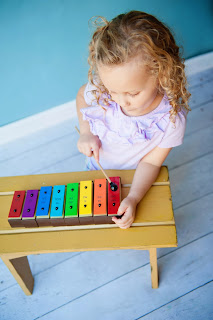I've Been to Harlem
This fun folk song gives students a chance to hear the same tune sung major, then again minor for comparison. Did you know your tone bells give you a chance to explore major and minor at home further?

As you'll remember from our posts on solfeg, DO could be on any note. With your bells, you can only make a complete major scale if DO is on C, but don't let that stop you from experimenting with assigning other bells to be Do.
Since your student is learning how to skip, have her pull out the C bell, and take a skip, and another to create the Red chord in C Major: CEG or Do-Mi-Sol. Play this chord and hear that it sounds Major. Try again starting with the F bell, to create the Red chord in the key of F Major: FAC. It also sounds Major, and is another Do-Mi-Sol; this time Do was F.
What if you start with D (DFA) or E (EGB)? This creates a Red chord in the key of D minor and E minor. Play it with your child and see if she can hear the difference. The minor triad is Do-Me-Sol, pronounced Doh-MAY-Soh.
With each of those groupings of 3 notes, it was the MIDDLE note that determined that the chord was major or minor. Without the middle bell you can't assign major or minor.
Here's a video of a 4-year-old student creating a few triads, and playing the song "I've Been to Harlem" in C Major and E minor. (You'll learn a lot more about triads in year 3). I don't recommend using your feet to hold mallets, nor drinking pickle juice for real.
How did that sound?
Major scales sound brighter and cheerier than the sad (or sleepy or spooky or somber) minor scales. Nothing beats experience and exposure for helping you learn to recognize the difference between major and minor. If you want some more practice, here is a short little ear-training quiz with some major and minor chords. Who got more answers correct, you or your child!?
Teacher Justine Turcott, in Rexburg, ID, shares a conversation between a first-year student and another 4 year-old as they made hot cocoa:
Jaymie: Did you put in enough powder?
Bailey: Yeah.
Jaymie: Well, are you sure? Does it taste Major or Minor?
Bailey: What?
Jaymie: Major is happy and Minor is sad. Does it taste Major?
Bailey: Yeah.
Jaymie: Well, are you sure? Does it taste Major or Minor?
Bailey: What?
Jaymie: Major is happy and Minor is sad. Does it taste Major?
Here at Let's Play Music, we love to give a multi-sensory approach to learning, and these students found a way to bring the sense of taste into the lesson, too!
The Cup Game
The song, "I've Been to Harlem" is also commonly used to play tricky cup rhythm games like this or this. Part of the fun is having a complex rhythm different from the rhythm of the song lyrics. I wanted to share the fun of a cup rhythm game with my young family, so we came up with a much simpler routine.
Before singing the song, help your child chant "Beetle, Butterfly, Clap- Pick, Pass" with a cup until she can remember the routine shown in the video below. The rhythm is beetle-butterfly-beetle-bug. Ask your child to keep thinking of that rhythm while you sing the song. Eventually she'll be able to sing along and keep the rhythm going, too.
Here's one Blue Bugs class with Let's Play Music teacher, Robin Flores in Windsor, Colorado playing the cup passing game. You can try it at home, too!
All ages find this game irresistible and will be singing "I've Been to Harlem" and requesting more chances to play the cup game! They laugh when they make a mistake and feel exhilarated when it works out.
I hope you find some time to extend your fun with "Harlem" and get more exposure to major and minor sounds this month.
- Gina Weibel, M.S.
Let's Play Music Teacher


LOVE this Gina!! Such a great way to make what they are learning in class super fun!!
ReplyDeleteWow! Love the cup game to incorporate fun with bugs, major & minor! Too much fun!
ReplyDelete